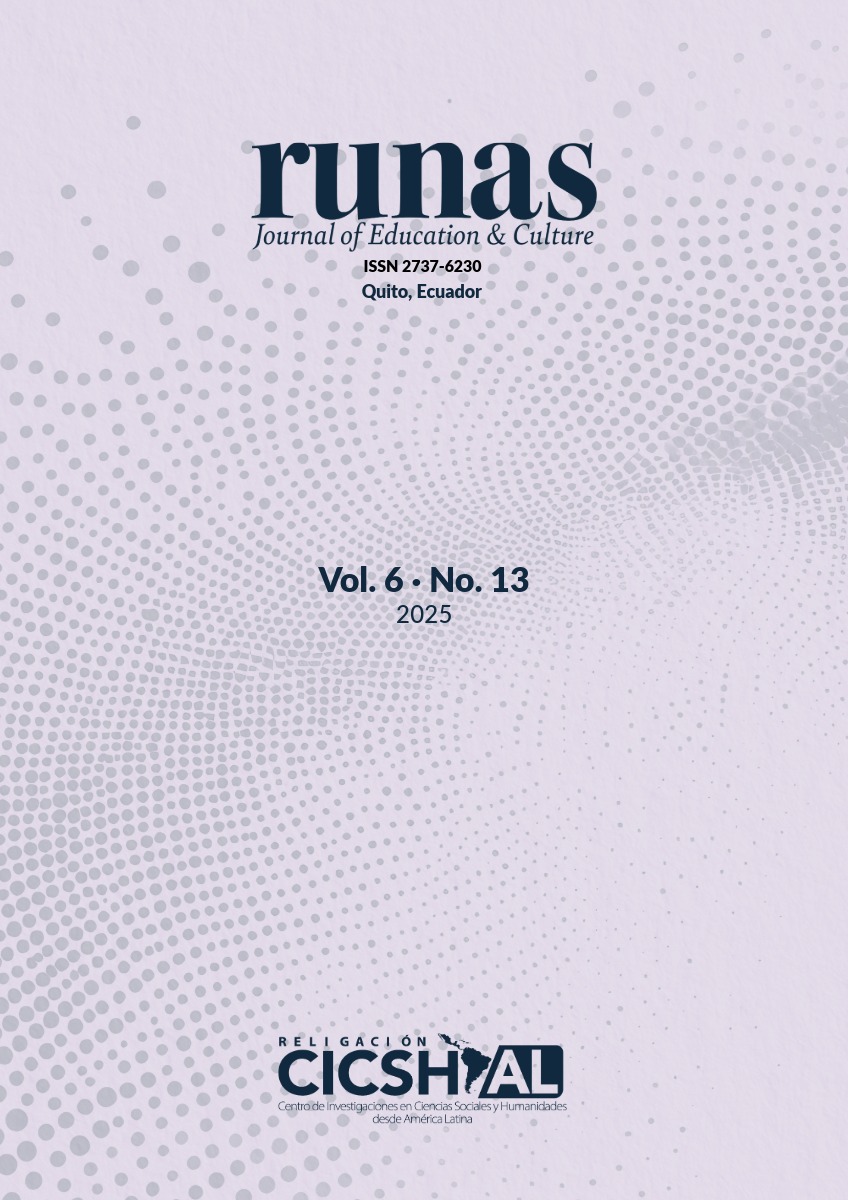Resumo
Este estudo analisa a importância do ensino de artes e da interseção entre literatura e cinema na formação integral dos estudantes no Equador, cujo potencial não está sendo plenamente aproveitado como ferramenta de aprendizagem substancial. O objetivo principal consiste em analisar a valoração docente sobre o ensino de artes e a interseção entre literatura e cinema no currículo educacional equatoriano, como base para evidenciar a necessidade de seu fortalecimento. Para tanto, empregou-se uma abordagem qualitativa a partir da aplicação de métodos teóricos durante a revisão bibliográfica, e foi aplicado um questionário a docentes, o qual mostra a existência de uma lacuna entre a teoria e a prática. Os resultados revelaram que, apesar de existir um consenso unânime entre os docentes que confirmam o valor dessas disciplinas na formação cognitiva, criativa e socioemocional, eles avaliam que estas estão parcialmente integradas no currículo, e a pesquisa demonstra que sua implementação na prática é limitada. A principal contribuição do estudo reside em conscientizar sobre a necessidade de utilizar o ensino de artes, a literatura e o cinema como eixos transversais na Educação Básica e no Ensino Médio. Recomenda-se ampliar a investigação para outros contextos equatorianos, a fim de fomentar e promover futuras reformas curriculares e políticas públicas.
Referências
Baas Chable, M. I., Barceló Méndez, M. G., y Herrera Garnica, G. R. (2012). Metodología de la investigación. Pearson Educación.
Cadme, F. G. (2023). Políticas educativas en artes: un análisis del sistema en el Ecuador. Reincisol, 2(3), 160-377. https://doi.org/10.59282/reincisol.V2(4)360-377
Carrasco, I. (2016). Análisis del componente “Educación Artística” en el currículo de Educación General Básica (EGB) y Bachillerato General Unificado (BGU) del Ministerio de Educación del Ecuador. Universidad Andina Simón Bolívar.
Chávez, G. (2022, 24 de julio). Lo que no se dice sobre la educación curricular en artes a nivel secundario - I parte. Universidad de las Artes.
Comolli, J.-L., y Sorrel, V. (2016). Cine, modo de empleo: De lo fotoquímico a lo digital. Manantial.
Díaz Herrero, S., y Gértrudix Barrio, M. (2021). El cine como metodología didáctica. Análisis sistemático de la literatura para un aprendizaje basado en el cine (ABC). Contratexto, (35), 225-253. https://doi.org/10.26439/contratexto2021.n035.4964
Eisner, E. (2002). El arte y la creación de la mente: El papel de las artes visuales en la transformación de la conciencia. Paidós.
Gills Arana, L. (2021). La crítica es una escuela: Conversaciones sobre la crítica de cine en América Latina (2018-2021). Universidad de las Artes.
Hernández-Sampieri, R., y Mendoza Torres, C. P. (2018). Metodología de la investigación: Las rutas cuantitativa, cualitativa y mixta. McGraw-Hill Interamericana Editores.
Jiménez Silgado, A., Hernández Rincón, E. H., Romero Tapia, Á., y Jaimes Peñuela, C. L. (2024). Limitaciones y beneficios de la educación médica a través del cine: una revisión sistemática exploratoria. Revista De Medicina Y Cine, 20(3), 339–352. https://doi.org/10.14201/rmc.31858
Lara, F., Ruiz, M., y Tarín, M. (2019). Cine y Educación. Academia de las Artes y las Ciencias Cinematográficas de España.
Machado, J. (2024, 2 de septiembre). Todas las materias y horas de clase tendrán los alumnos el año lectivo 2024-2025 en Ecuador. Primicias.ec. https://n9.cl/hmmjy
Mardones, M., y Cataffo, A. (2016). La Secundaria de Arte en el Sistema Educativo Argentino. Educación Artística y obligatoriedad en el marco de la ley de Educación Nacional 26.206. Arte e Investigación, (10), 123–128.
Ministerio de Cultura y Patrimonio del Ecuador. (2022). El Plan Vigesimal de Educación y Formación en Artes, Cultura y Patrimonio.
Ministerio de Educación del Ecuador. (2019). Currículo Nacional de Educación Obligatoria: Subnivel Medio.
Ministerio de Educación del Ecuador. (2024). Lineamientos pedagógicos para el año lectivo 2024 - 2025.
Ministerio de Educación Nacional de Colombia. (1997). Serie lineamientos curriculares: Educación Artística.
Nieto Ratero, A., y Cabezas Alarcón, J. (2024). El uso del cine en la educación: Una revisión sistemática desde una perspectiva didáctica. European Public & Social Innovation Review, 9, 01-19. https://doi.org/10.31637/epsir-2024-851
Oliver, M. (2020). De Finlandia a Nueva Zelanda. Las artes en educación infantil. Arte, Individuo y Sociedad, 32(2), 467-484.
Rueb, M., Rehfuess, E. A., Siebeck, M., y Pfadenhauer, L. M. (2024). Cinemeducation: A mixed methods study on learning through reflective thinking, perspective taking and emotional narratives. Medical Education, 58(1), 63-92. https://doi.org/10.1111/medu.15166
Salas Martínez, J. L., Rusillo Magdaleno, A., y Suárez Manzano, S. (2022). Beneficios de la dramatización en las habilidades sociales y desinhibición de niños y niñas. Una propuesta práctica. EmásF: revista digital de educación física, (75), 268-282.
Séguin-Vergara, J. (2007). Teaching with films in the French educational system [La enseñanza del cine en el sistema educativo francés]. Comunicar, 29(29), 21–25. https://doi.org/10.3916/C29-2007-02
Svensson, V. (2013). Relaciones entre cine, literatura y educación. Revista Pilquen - Sección Ciencias Sociales, 16, 1-13.

Este trabalho está licensiado sob uma licença Creative Commons Attribution-NonCommercial-NoDerivatives 4.0 International License.
Copyright (c) 2025 Julianne Allen Sotomayor, Mirtha Manzano Díaz





